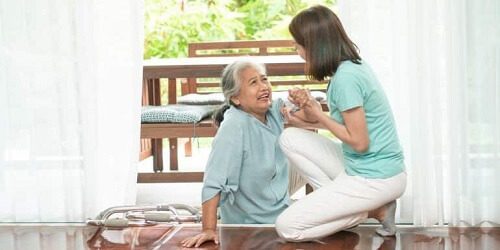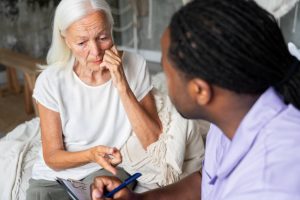The fear of falling is particularly pervasive within the home, where people walk around less cautiously because of a false sense of security. Falling, being unable to get back up, and not having a way to access a phone to call for help make it riskier for someone who lives alone. Before they are found it could take days or even hours.
For these reasons, designing a home where older persons can move around in safely is the first step in fall prevention. It does not require huge modifications to make improvements to ensure your elderly loved one’s home is as fall-proof as possible. To increase in-home safety, a few fundamental modifications and lifestyle changes are all that are necessary.
The following 10 Ways to Prevent Falling at Home:
1. Look for fall hazards and remove them;
- Clear the clutter from your home. Pick up any items, such as papers, books, shoes, cartons, or other things, that you might trip over.
- Never allow anything to block your stairway.
- Ensure that all floorboards and steps are secure and level.
- Any rugs should be taken out or securely taped down.
- Make sure there are not any items or pieces of furniture like coffee tables that obstruct the way in your house.
- Any extension, phone, charging, or electronic cables should be taped or bundled near the wall.
A fall can be caused by a home fixture often, which can cause back pain and other problems. Check each room and corridor for anything that might be loose, slippery, or protruding floorboards made of wood. To prevent falls more successfully, fix, take out, or replace certain items.
2. Use Assistive devices & handrails;
There are many many products available on the market that assist elderly people in securely accessing their houses. These consist of grab bars for the toilet and shower/tub, non-slip treads for steps made of bare wood, and handrails for stairs on both sides. To avoid falls when showering, you can also install a robust plastic seat, a non-slip mat, and a handheld nozzle. Make sure your loved one utilizes a cane or walker in the home to maintain stability if the older adult’s doctor advises it.
3. Ensure sufficient lighting;
A house with poor lighting might be harmful. Where brighter bulbs are required install them, especially in stairways and small hallways. A lamb should be placed close to the bed in case you need it in the middle of the night, along with twinkle lights that may be plugged into the bedroom, bathrooms, and corridors. In the case of a power outage, keep flashlights in central places, and tell your loved one to turn on the lights before climbing stairs.
4. Verify Medications or Prescription;
Older persons may have dizziness as a side effect of some drugs, which increases the risk of falls. Discuss potential side effects of drugs with their doctor or pharmacist to have your elderly loved one take extra care when taking the medication. Make sure to warn other caregivers about these side effects as well.
5. Put on shoes or slippers;
A fall risk exists when moving around the house in either bare feet or socks. Keep a pair of indoor shoes, sliders, or pajamas on hand, and advise your loved one to wear them. To help prevent slips you can also buy non-slip socks with grips on the soles.
6. Avoid dressing in loose-fitting clothing;
Although loose-fitting clothing is comfortable it could cause a tripping hazard, if it bunches up or drags on the ground. Make sure the elderly person only wears clothing that is well fitting and hemmed.
7. Live on one level;
Living entirely on one floor will protect your elderly loved one from the risks of falling when using stairs. If that isn’t possible, make as many of the moves onto the same floor as you can to reduce the number of trips they need to go up and down the stairs.
8. Move carefully and get up slowly;
When moving from lying down to sitting up and from sitting up to standing, take your time.
Be careful while you climb and down the stairs. Go slowly and use the handrail. Take extra care when carrying heavy items.
Falls can occur when someone moves too quickly, especially when utilizing stairs or changing position suddenly from sitting to standing and vice versa. Encourage your loved ones to move slowly.
9. Examine your eyes;
At least once a year, have your eyes checked by an eye doctor to see whether you need glasses or if your prescription needs to be updated.
Spend some time getting adjusted to your new glasses or contacts when you first get them.
Things can appear closer or further away than they are with bifocal and progressive lenses. When you’re walking or engaging in outdoor activities, having a pair of glasses with merely your distance prescription can assist you to avoid falling.
10. Join a preventive exercise program;
Exercise programs for senior citizens designed to prevent falls are commonly accessible at community centers, gyms, and health care facilities. These workout plans emphasize muscular building and balance improvement. To keep you safe, a physical therapist might also suggest exercise routines and tools.
Fall prevention also means injury prevention for senior citizens. Ask your family members for assistance in making sure that your rooms and stairways are clutter-free and well-equipped with lighting, handrails, grab bars, and nonslip mats. All of these things can help to keep you safe in your room. Having a suitable medicare plan helps to reduce unexpected medical costs if a fall does happen.





